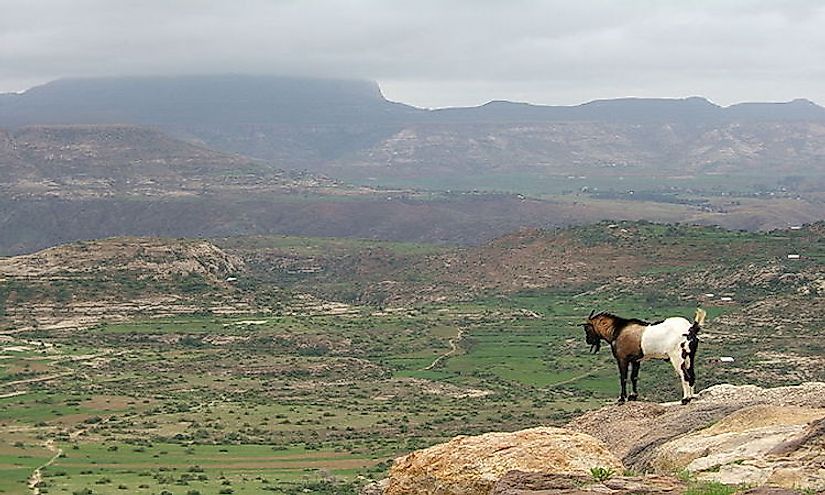Ecological Regions Of Ethiopia

Ethiopia is a landlocked country in the horn of Africa. It is bounded by Sudan to the west, Eritrea to the north and Kenya to the south. It borders Djibouti and Somalia to the east. Ethiopia has extremely variable agro-climatic conditions and major ecological systems that are suitable for diverse genetic resources. In the agro-ecological zones, small-scale subsistence farming is widely practiced in the highlands and livestock keeping in the lowlands. The ecoregions of Ethiopia are widely used for extensive grazing systems. The local communities and pastoralists come up with regulations aimed at efficient and sustainable use of resources. For example, pastoralists are not allowed to cut trees, which are considered to be of very high value, but instead feed their livestock on other available resources such as bush and grass. Here are the major ecological regions of Ethiopia.
The Major Ecological Regions In Ethiopia
Ethiopian Montane Grasslands And Woodlands
This ecoregion covers two of the major Ethiopian mountain massifs (Eastern and Western) and separated partly by the Great Rift Valley. It is biologically rich and has endemic species such as Walia ibex (Capra walie) and the endangered mountain nyala (Tragelaphus buxtoni). It is the most arable land in Ethiopia and hence very populated. This poses a threat to this ecosystem due to human activities and modification. As a result, intact vegetation is fragmented and far spaced in the woodland/grass complex. This leaves the Bale National Park region as the only place in this ecoregion that has intact vegetation types. The subsistence farming and high population density of 100-400 people per square kilometer have made this ecosystem to be in a critical conservation status.
Ethiopian Montane Forests
The montane forest ecosystem is made up of high forests of the country mainly found in the southwest forest areas and the humid forest of the southeastern plateau (Herrena forest).These forests are the wettest and most humid. The forest is stratified into four different layers known as the upper canopy, sub-canopy, shrub layer and the ground layer. Each layer is occupied by different characteristic species such as emergent trees of Pouteria adolfi–friederici and Afrocarpus falcatus in the upper canopy. This forest ecosystem is also distinguished by the growing epiphytes such as Canarina, Orchids and fern plants. This ecosystem is an important source of timber, non-forest timber products, fuelwood, household materials, pasture and agricultural use. The main threat is posed by human activities in the form of pastoral grazing, coffee and tea plantations and timber extraction.
East Sudanian Savanna
The East Sudanian savanna is hot and dry and composed of wooded savanna vegetation types such as Terminalia and Combretum shrub and tree species. The tall elephant grass (Pennisetum purpureum) is also common in this wooded savanna ecosystem. This ecosystem is found in low altitudes of between 200m and 1000m which is topographically flat. The average monthly temperatures vary from 30° to 33°C and the lowest temperatures at 18°C and 21°C. the habitat has been greatly affected by human activities such as agriculture, fire, charcoal burning, and wood clearance. This has in turn affected the population of larger mammal species such as elephant (Loxodonta Africana), the wild dog, leopard, and cheetah. This savanna ecosystem is still intact in terms of original woodland habitats in comparison to the West Sudanian savanna which is very much affected and degraded. The local populations offer the main threat to this ecoregion through their grazing and herding activities. Over hunting and poaching for trophies has also become rampant in recent years creating a new threat to the animal species.
Threats To Ethiopia's Ecological Regions
Other ecological systems include Sahelian Acacia savanna, Victoria Basin forest-savanna mosaic, Ethiopian xeric grasslands and shrublands and Ethiopian montane moorlands. These ecoregions face a major threat from human interference in form of agriculture, poaching, and human encroachment. The original species continue to reduce and intact vegetation is hard to find.
Ecological Regions Of Ethiopia
| Ecological Regions Of Ethiopia | Biome |
| East Sudanian savanna | Tropical and Subtropical Grasslands, Savannas, and Shrublands |
| Ethiopian montane forests | Tropical and Subtropical Moist Broadleaf Forests |
| Ethiopian montane grasslands and woodlands | Montane Grasslands and Shrublands |
| Ethiopian montane moorlands | Montane Grasslands and Shrublands |
| Ethiopian xeric grasslands and shrublands | Deserts and Xeric Shrublands |
| Masai xeric grasslands and shrublands | Deserts and Xeric Shrublands |
| Northern Acacia-Commiphora bushlands and thickets | Tropical and Subtropical Grasslands, Savannas, and Shrublands |
| Sahelian Acacia savanna | Tropical and Subtropical Grasslands, Savannas, and Shrublands |
| Somali Acacia-Commiphora bushlands and thickets | Tropical and Subtropical Grasslands, Savannas, and Shrublands |
| Victoria Basin forest-savanna mosaic | Tropical and Subtropical Grasslands, Savannas, and Shrublands |











